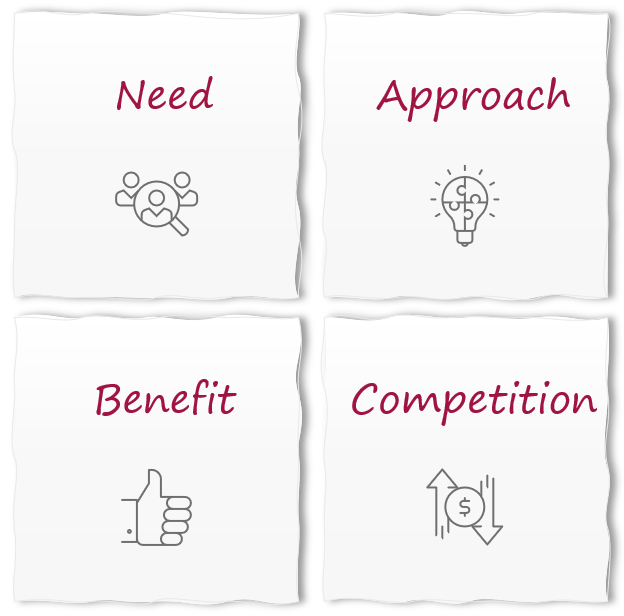# Ideate
# NABC
- Purpose
- Quickly grasp the essence of ideas
- Time required
- 20 to 40 minutes
- Participants
- Design Thinking team
- Level of experience
- Beginner
# What is it about?
Using the four basic questions Need, Approach, Benefit and Competition, ideas can be clearly structured in a 2x2 matrix, called the NABC cross. NABC can be used for different application scenarios, but is particularly useful for business ideas.

# The goal
The goal is to quickly grasp the core of the idea. This can be achieved by looking at the idea from the following four different perspectives:
- Need: Who are the typical customers or users of the idea? What is the problem that needs to be solved? What is the need behind it?
- Approach: How should the problem be solved? What is the solution? What is the performance promise?
- Benefit: What is the benefit for the user? What is the benefit for the company?
- Competition: What alternative solutions are there? Who are the competitors? What other hurdles are there?
# How to do it?
- Draw a 2x2 matrix (NABC cross).
- Start with the problem/need:
- Customer's problem
- Typical customer or typical situation in which the problem occurs
- Continue with the approach to the solution:
- Problem solution, product/service/process, the underlying business model
- Continue with the benefit:
- Benefit for the customer, the company, ...
- Finally, the last quadrant (Competition):
- Alternatives and competitors (current and future)
- Unique selling points of the solution
# When do you need it?
This tool is primarily used to illustrate the essential aspects of an idea and is therefore suitable for a pitch, for example. The initial focus on the problem/need also means that concrete solutions emerge at the end of this method. NABC is therefore also suitable for generating ideas for a known customer problem.
# Resources
- paper
- pens
- alternativ: digital whiteboard
- template for NABC
# Advantages
The biggest advantage of this method is that it can be used for a wide variety of application scenarios. The clear categorization helps to identify the essential aspects and communicate them in an understandable way.
# Disadvantages
The disadvantage is the limited space, as the NABC cross is usually only shown on one side to ensure clarity.
# Keep in mind
This tool is primarily a customer-oriented method that focuses on the customer and their problem or need. Also note that the NABC cross should generally fit on one page to ensure clarity.
# See also
| Previous methods | Alternative methods | Following methods |
# Sources
- Lewrick: Das Design Thinking Toolbook: Die besten Werkzeuge & Methoden (German) (opens new window) Vahlen. ISBN: 3800657511.
← Mindmapping TRIZ →